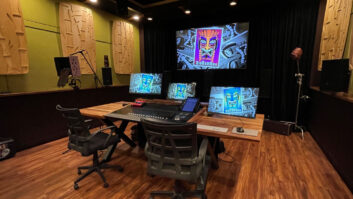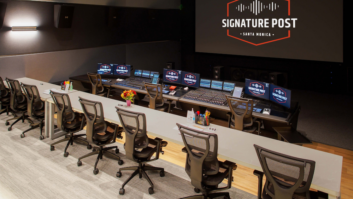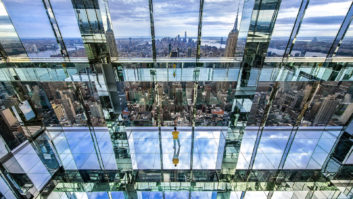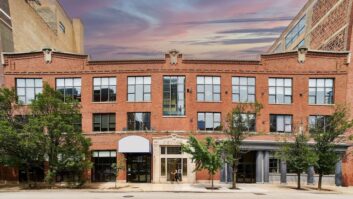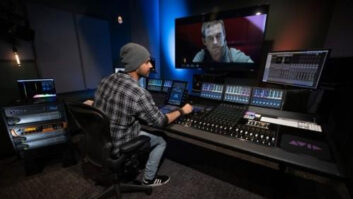PDiddy is up on the Avid screen in one of the 11 video-editing suites at Goldcrest Post Production’s facility on the far-west fringes of Manhattan’s West Village. The video, which made FedEx either very happy or very nervous, is everything you’d expect to be going down at a hip post house in New York these days: Urban music videos, indie film work and the occasional commercial, as the city’s advertising business continues to rebound from a lousy economy and September 11.
But Goldcrest isn’t your typical New York post house. The principals of Goldcrest Films International, SoHo and London came to town two years ago with a feature-film pedigree that most non-Hollywood post facilities would die for (Local Hero, Chariots of Fire, Gandhi, The Killing Fields, All Dogs Go to Heaven and A Room With a View, among many others). The company’s owner, John Quested, led a management buyout in 1987, and is the sort of English film producer long missing from the business: quirky, serious and relevant. His son attended film school in Manhattan and is on the cusp of a career in music video and feature film, as well. So neither Hollywood nor Pinewood, but hardwood Manhattan floors and beams are what Goldcrest’s technology infrastructure is built upon.
Goldcrest recently updated that infrastructure by putting the finishing touches on a major audio expansion in Manhattan, including a new film mixing theater equipped with a 48-input Harrison Series 12 console, a pair of new Digidesign Version 5.1 Pro Tools suites and a dedicated Foley room. A single Pro Tools suite had served as its main audio department since the facility opened in 1999.
CHANGING ECONOMICS
Goldcrest is expanding at a time when both the U.S. and global post-production industries are undergoing tremendous consolidation, no better illustrated than by the emergence of Liberty Livewire as a post colossus in the wake of a two-year-long facility acquisition spree. In New York, Liberty acquired the Sound One and Todd-AO facilities, as well as the Planet 10 Post editorial house.
“The Sound One/Todd-AO culture is significantly different from that of Goldcrest,” observes Jeremy Scott, facility director in New York. “They’re a very complex organization, with a large staff, and they’re part of an even larger publicly held company, which has shareholders to answer to as well as clients. Goldcrest is a simpler operation, yet we’ve structured it so that we can service both feature film work and video and broadcast post.” Recent Goldcrest projects in New York include 52 episodes of the Disney Channel’s The Book of Pooh; commercials for Sprite, Prudential and Bell South; and music videos for Destiny’s Child, Dido, Sean “Puffy” Combs and Brandy.
Perhaps the biggest difference in business philosophies is that Goldcrest has very few on the regular payroll — primarily operations and maintenance personnel. The rest — the editors and engineers — are freelancers, many of whom bring their own clients to the facility. That, says Scott, has kept the operation leaner and better able to weather the periodic bumps in the post business. It’s a model that has also worked well at Goldcrest’s London studios, where the Livewire touch has also been felt.
“Liberty had started taking over companies in London, such as TVI and MPC, but we didn’t really feel the heat from that,” Scott says. “When you get that big, you become cumbersome, and that can lead to the customer getting less attention. You also get higher employee turnover. On the other hand, we, and our clients, like the energy that the freelance situation brings. When you have a large variety of clients in here, and offbeat ones like Steve Buscemi coming in to do ADR, it’s nice to have an equally eclectic array of engineers to choose from.”
A corollary to Goldcrest’s approach to human resources is its emphasis on not carrying facility or equipment lease payments. The company bought its building outright, as well as the Avid editing systems and other gear. The total investment in the physical and technological infrastructure, including a 52-seat, state-of-the-art screening theater, is estimated at around $20 million. Another round of investment is looming, as the studio finishes off the new audio expansions. “The business model has always been to pay cash as we go along,” says Scott.
The audio expansion was inevitable, and it was needed to match the initial large investment in video editing. Since opening, Scott estimates, Goldcrest in New York was buying nearly an Avid a month. “All that was generating an increased need for music, dialog, sound effects and mixing,” he says. Independent contractors have been coming in with their own equipment, mostly Digidesign Pro Tools systems, and two dedicated Pro Tools 5.1 suites are being added, with more under consideration. They will augment the new mixing theater, which was designed by Jim Mayor.
Until this point, the closest that Goldcrest has come to a regular audio presence on-site is Joe Deihl, a veteran of the New York post community since 1980, with a very eclectic curriculum vitae in film, commercials, corporate audio, music video, broadcast, music engineering and sound design. Deihl is an independent contractor but is ensconced daily in Goldcrest’s lower-level audio studio, where he does ADR and music recording from an open control room with a small iso booth behind it, and a 5.1 array of Genelec speakers in front and 5.1 Pro Tools system with Pro Control.
Deihl is a good match for Goldcrest’s approach. He revels in the notion of a jack-of-all-trades. “I read in Mix how the Hollywood style is to have four guys on the mix, one for each audio element,” he says. “In New York, one guy does it all much of the time.” Deihl brings in his own clients to the facility, but says he gets an almost equal amount of work from the studio, particularly ADR projects. Deihl and Scott contend that technology, specifically server-based distribution systems, will allow for this higher level of productivity with fewer people. An Avid Unity server is already in place in the facility’s central machine room, and the new audio rooms will be hooked into that, as Deihl’s already is.
“I think with a system like that, we can be a hybrid of Hollywood and New York, only faster and more efficient,” he says. (Earlier that day, Deihl had created the sound effects of P. Diddy’s FedEx plane that was whooshing across the Avid screen upstairs.) “Post-production has been under pressure in New York for a while now, for a variety of reasons. And this lean way of approaching it is a very good response as the economics of the business change.”
And that’s why Goldcrest is in New York in the first place, says Scott. “The economics are changing, varying every day. One moment, video is down but film is strong, and then that’s reversed. New York has been doing more independent film work in recent years, and that’s part of Goldcrest’s heritage. I further think that New York is going to be seeing significantly more major feature film work. People have been scared off a bit by the economy and recent events. But people still talk about expanding the city’s film infrastructure, such as the facilities being planned at the old Brooklyn Navy Yard. Also, there are no real rate standards in New York — a lot of projects are negotiated on an individual basis. That’s why being lean and able to keep the overhead low and put the investment into equipment is important. It gives you the ability to react more quickly as things change. And that’s been the way we’ve been working all along.”
Dan Daley is Mix ‘s East Coast editor.


